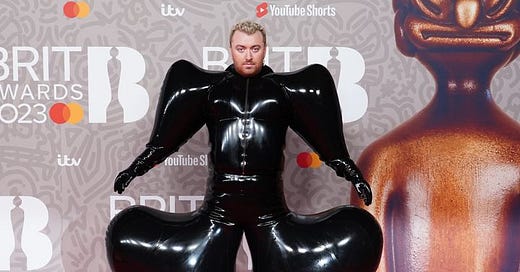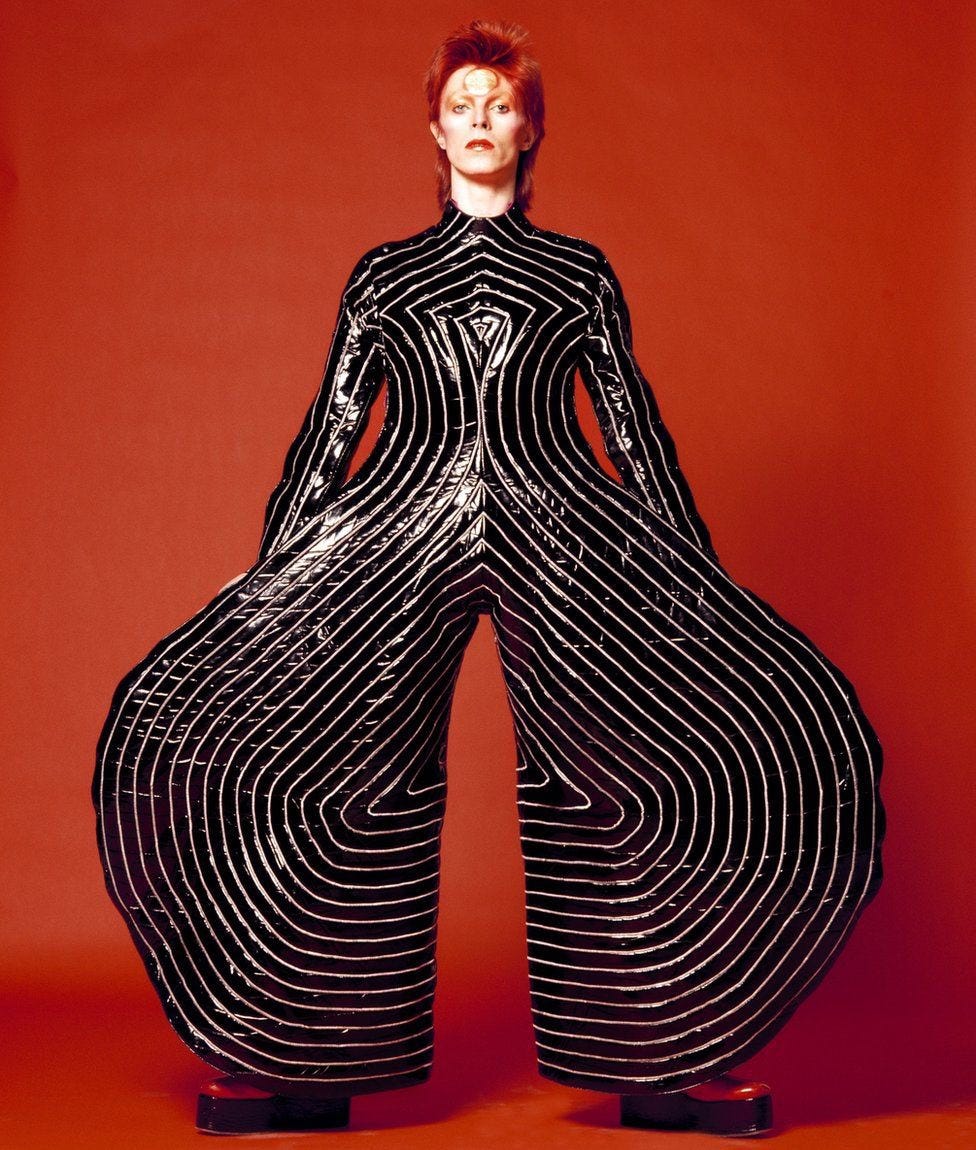Catchiness and coolness
How we can use childhood traditions, Sam Smith's Brits outfit and Rihanna's half-time show to help plan great campaigns.
This week, my LinkedIn feed has mainly been a combination of a) pictures of Rihanna rubbing her belly during the Super Bowl half-time show or b) pictures of Sam Smith's outfit from Saturday night's Brit Awards. Or both. Well, those plus the now steady drumbeat of thought pieces on GPT and other generative AI tools.
Our fractured, diffuse media landscape has generally done away with what we might have called watercooler moments pre-pandemic. But the Brits and the Super Bowl rolled back the years (a pretty long way when it comes to the Brits) and got everyone talking. My barometer for whether or not a meme or story has crossed over into "the real world" (i.e. people outside of marketing and comms) is my family WhatsApp groups - and a bunch of Sam Smith memes popped up there.
You'll be pleased to hear I'm not planning any fashion-based commentary on Sam's outfit - although I will say David Bowie posed in something startling similar BITD. I'm interested in why specific stories or images still can capture the popular imagination, even when we all exist in our own little multi-narrative worlds.
Some trends and topics have the power to transcend the artificial walls our preferred platforms and media outlets put up between us and become recognisable by a critical mass of people. How does this happen? What is it about Sam Smith's outfit or Rihanna's super bowl performance that makes us want to share and discuss them quite so much?
It's a secret sauce that many claim to know the recipe for, but few can make happen with any absolute certainty. And I could mention some basic building blocks like "you need a great picture", which, while undeniably true, leaves a lot of blanks to fill in. What makes a great picture? If Rihanna doesn't rub her belly, announcing her pregnancy, do the images from her show have the same impact? Would anyone else wearing Sam Smith's outfit have the same effect, or is this the latest flashpoint in the media narrative around his most recent video and new album?
Banal truth time - there's no secret sauce and no way of predicting what will take off and become a bona fide trend and well-shared meme. I was working on a campaign for Lucozade back in 2013, and we all got very excited about the Harlem Shake and our ability to ride that dance to awards glory. It never happened; it was too hyped to be cool. But that truth is only visible in the rearview mirror.
To understand why certain things catch on and become almost universally shared, I returned to one of my favourite reads of 2022, Why Did We All Have the Same Childhood? in The Atlantic. The piece explores why things like drawing a blocky, graffiti-style S on your notepad or writing boobs on a calculator are almost universal childhood behaviours in the US and UK.
It also contains an idea of what makes certain childhood games popular and shared across generations and geographies. According to Alex Mesoudi, who studies cultural evolution, there are two significant factors - catchiness and coolness. Catchiness being a proxy for memorability and stickiness - it's not complicated to write boobs on a calculator. Still, even more importantly, it's not complicated to SHOW someone how to write boobs on a calculator. It's an analogue behaviour that's easy to share and replicate. Judging coolness is about understanding where you hear about a trend; if that context is "high-status" - i.e. it already feels popular, or the cool kids are into it, it's more likely to catch on.
If we apply catchiness and coolness to Sam Smith's outfit and Rihanna's half-time show, we can easily see the catchiness. Both can be distilled into one simple image that you can introduce with a straightforward question - "did you see Sam Smith's Brits outfit?" or "did you see Rihanna's half-time show?". Immediately you're into the story - either the person you're asking the question of knows what you're talking about, or they can quickly Google the question, get the answer and then get involved in the conversation. The barrier to entry is way low.
The coolness factor presents a divergence between my two trends. The Super Bowl half-time show generally always carries an air of cool and has produced memorable memes and moments over the years. Think Prince doing Purple Rain the rain in 2007; when I write "left shark," I'm pretty sure most of you will know what I'm talking about. The Brits are a long way from their 90s heyday, with the Spice Girls rocking Union Jack dresses and Jarvis Cocker wiggling his bum during a Michael Jackson performance. For Sam Smith, the coolness factor comes from the fact that, as I mentioned earlier, his latest video was already a hot topic of discussion. Wearing an outfit that, even to my untrained, non-fashionista eye, is a bit silly and can be turned into easy meme fodder, he's fanned those hot flames of discussion.
While I'm not going to claim that catchiness and coolness represent any secret sauce regarding campaign planning and creative idea generation, they DO present useful filters to run your thinking through. If you want your idea to catch on, be shared and be easily understandable in a range of different contexts, it needs to be simple. Go easy on the key messages. Make sure that you can explain it in one sentence. And try to ensure that someone you've explained it to can explain it to a third person in one sentence. I know it's hard, and sometimes we're planning by committee, and everyone's message is the most important, but if you want your story to be in any way memorable, it has to be simple.
To elevate your coolness, think about how you can link your ideas and campaigns to the cultural zeitgeist. What are the "high-status contexts" for your audience, whether consumers, media or policymakers. They all have things on their minds - linking your ideas into those contexts will instantly make you more memorable. And don't forget the cool kids - I know we're down on the concept of "influencers" at the moment, but aligning your idea, product or service to people with significant cultural clout and relevance has been around as long as communications itself. Just because "hiring a celebrity for your campaign" feels a bit hackneyed and PR 101 doesn't mean it won't work. Clearly, you need to find a suitable influential figure, not just any old rent-a-celeb. Still, if you get the partnership right, their reflected coolness will rub off on your campaign and increase your likelihood of getting your audience talking.
Your campaign probably won't end up getting to the level of Sam Smith's Brits outfit, but with a healthy dose of catchiness and coolness, you'll at least get away from existing as a bunch of organic social posts that no one reads.





